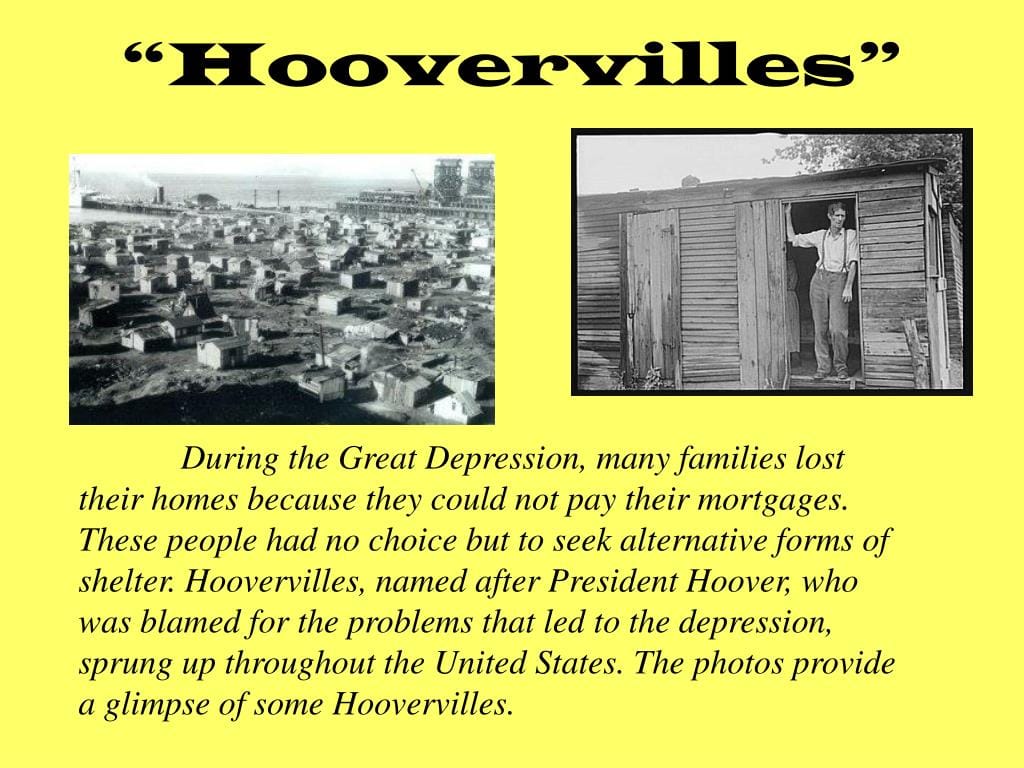Picture America in the 1930s: the Great Depression has crippled the nation, leaving millions jobless, homeless, and clinging to hope. With nowhere else to go, families built makeshift towns from scraps, grim reminders of their struggles. These were the Hoovervilles.
Why “Hoovervilles”?
The name was a direct jab at President Herbert Hoover, held responsible by many for the Depression’s devastation. It symbolized their anger at his perceived inaction while they suffered. These shantytowns became a visual representation of their plight.
Life Inside a Hooverville
Imagine dwellings cobbled together from cardboard, tar paper, or whatever scraps could be found—a far cry from comfortable homes. Life was harsh: disease spread rapidly, hunger was a constant companion, and the elements posed a daily threat.
Yet, even in these dire straits, a profound sense of community flourished. Residents shared their meager resources, offering support and a helping hand to their neighbors. They organized protests, demanding attention and action from a government seemingly indifferent to their suffering.
Hoovervilles weren’t just physical spaces; they evolved into powerful symbols of resilience, ingenuity, and the strength of the human spirit in the face of adversity.
Hoovervilles: More Than Just Slums
Were Hoovervilles merely slums? While they shared some characteristics, such as poverty and inadequate housing, important distinctions set them apart.
Key Differences:
- Temporary Existence: Hoovervilles were born of desperation and intended as temporary solutions. Residents clung to the hope that their situation was transient, that better times lay ahead.
- Community Over Chaos: Despite immense hardship, a remarkable spirit of cooperation and mutual support thrived within these shantytowns. They weren’t just places of despair, but communities actively trying to improve their circumstances.
- A Powerful Political Statement: The very name “Hooverville” was a pointed critique, directly blaming President Hoover for their plight and highlighting the government’s perceived failure to act.
The Enduring Legacy
Though Hoovervilles gradually disappeared with the economic recovery of the late 1930s, their legacy continues to resonate. They stand as:
- A Stark Reminder: Hoovervilles serve as a solemn reminder of the devastating impact of economic collapse on individuals, families, and society as a whole.
- A Testament to Resilience: They embody the extraordinary capacity of the human spirit to adapt, innovate, and find strength in community during even the darkest of times.
Beyond the Surface: Uncovering the Untold Stories
To truly understand Hoovervilles, one must delve into the personal stories of those who lived there. Their experiences, captured in oral histories, letters, and diaries, offer invaluable insights into their struggles, resilience, and the social dynamics within these unique communities. They remind us that behind the statistics and historical accounts were real people fighting for survival and dignity.
Exploring Further:
If you’re interested in exploring other aspects of history, you might find these articles intriguing:
- For a glimpse into the dangerous world of organized crime, check out our collection of pictures of dead Pablo Escobar.
- To delve into the unsettling phenomenon of hidden occupants, read about the chilling experiences associated with phrogging.
Hoovervilles, though physically gone, remain a powerful symbol of a turbulent period in American history. They remind us of the importance of social safety nets, the need for government intervention during crises, and the enduring strength of the human spirit.












